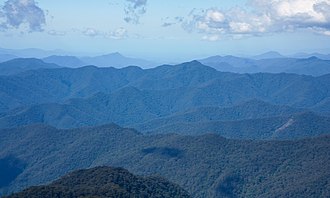New England Tablelands | |||||||||||||
|---|---|---|---|---|---|---|---|---|---|---|---|---|---|
 View west over the New England Tablelands from Point Lookout. | |||||||||||||
 The interim Australian bioregions, with New England Tablelands in red. | |||||||||||||
| Country | Australia | ||||||||||||
| State | Australia | ||||||||||||
| Area | |||||||||||||
• Total | 30,022 km2 (11,592 sq mi) | ||||||||||||
| Elevation | 600–1,500 m (2,000–4,900 ft) | ||||||||||||
| Mean max temp | 9–17 °C (48–63 °F) [3] | ||||||||||||
| Mean min temp | −3.6–6 °C (25.5–42.8 °F) [3] | ||||||||||||
| Annual rainfall | 653–1,765 mm (25.7–69.5 in) [3] | ||||||||||||
| |||||||||||||
New England Tablelands (code NET), an interim Australian bioregion, is located mainly in New South Wales, [4] [5] comprising 3,002,213 hectares (7,418,630 acres), [1] of which 2,860,758 hectares (7,069,090 acres) or 95.23 per cent of the bioregion lies within New South Wales; and the residual within Queensland. This bioregion is one of the smaller bioregions in NSW, occupying 3.57 per cent of the state. [6]
Contents
The New England Tableland Bioregion is a stepped plateau of hills and plains with elevations between 600 and 1,500 metres (2,000 and 4,900 ft) on Permian sedimentary rocks, intrusive granites and extensive Tertiary basalts. [2] Rainfall varies considerably from 653 to 1,765 millimetres (25.7 to 69.5 in) [3] and mean temperatures range from −3 to 17 °C (27 to 63 °F), [3] based on changes with topography. In terms of plants, the region is dominated by stringy bark/box/peppermint species, including Eucalyptus caliginosa , E. nova-anglica , E. melliodora and E. blakelyi . [7]